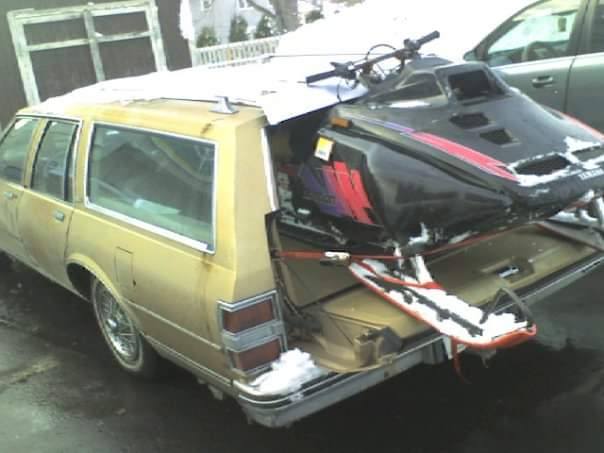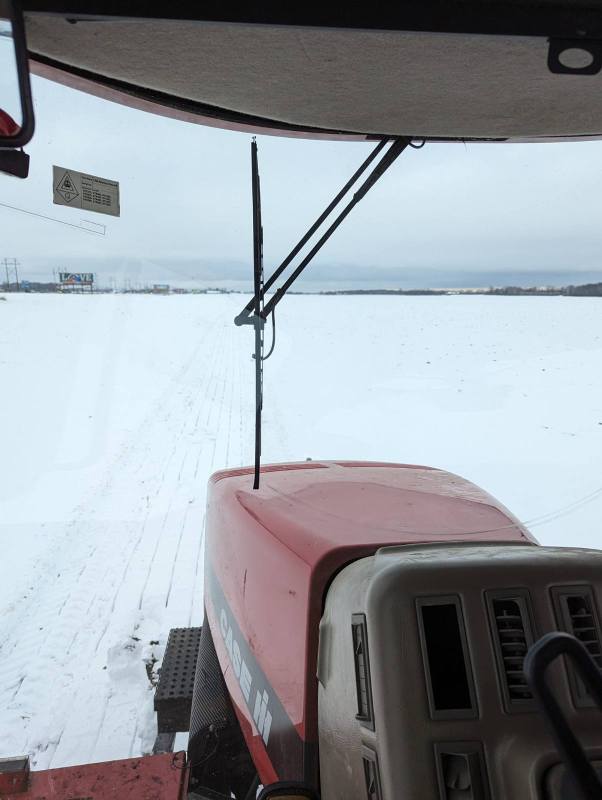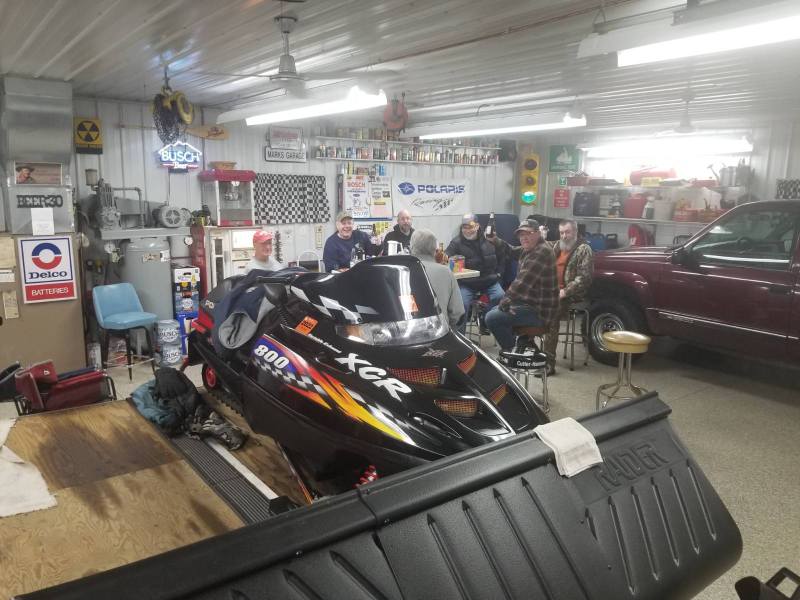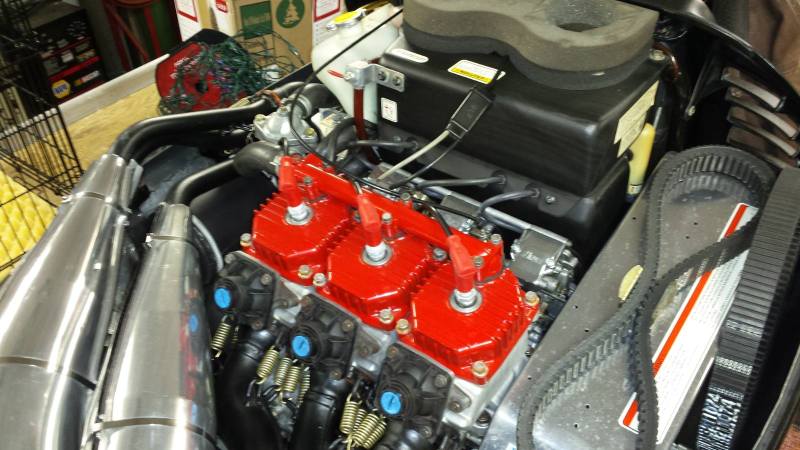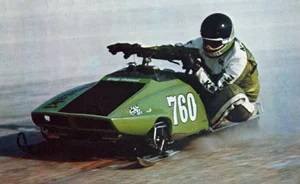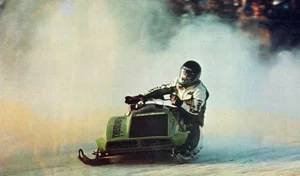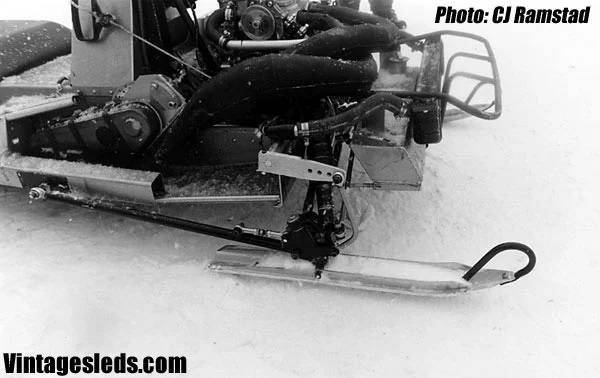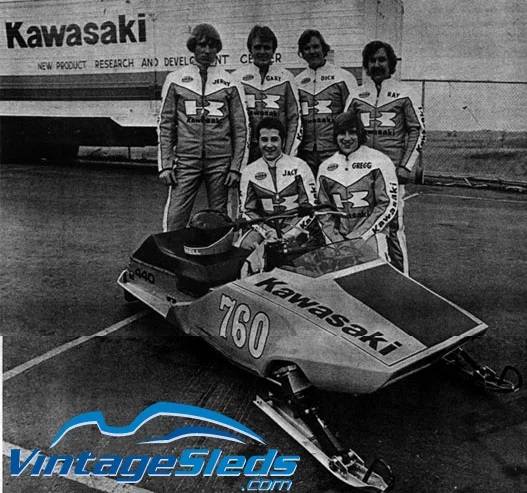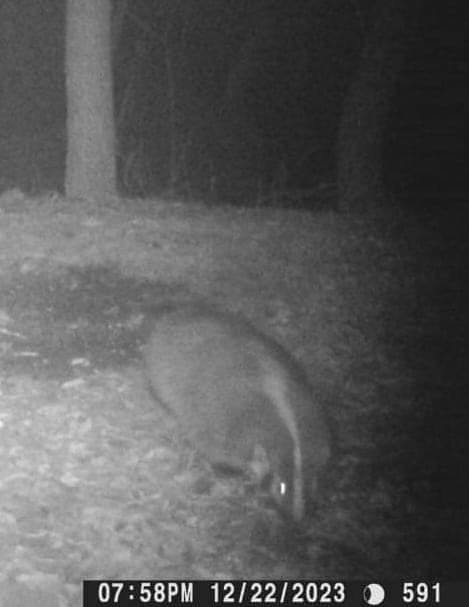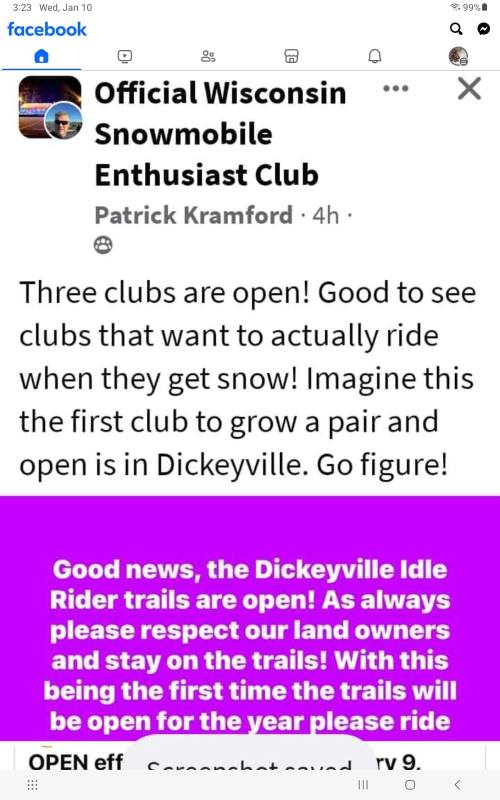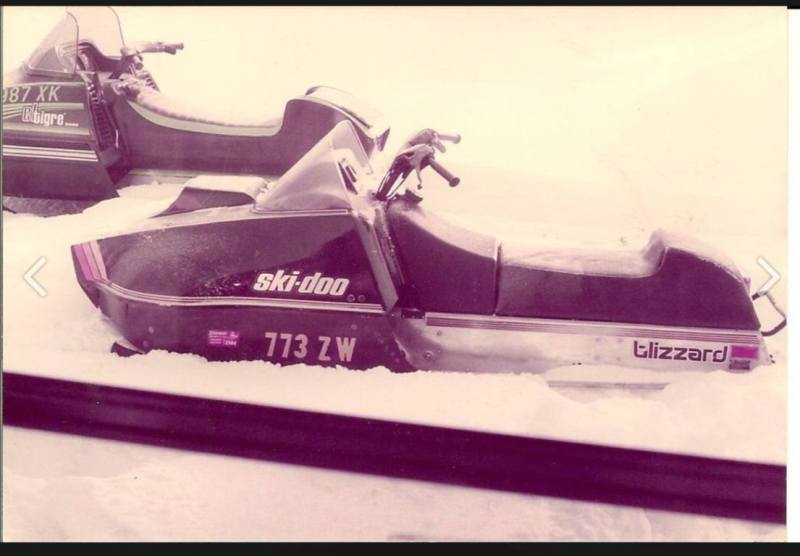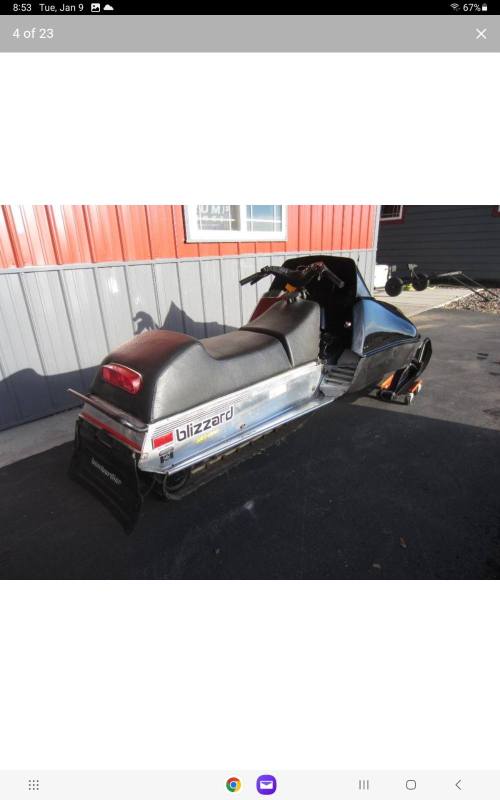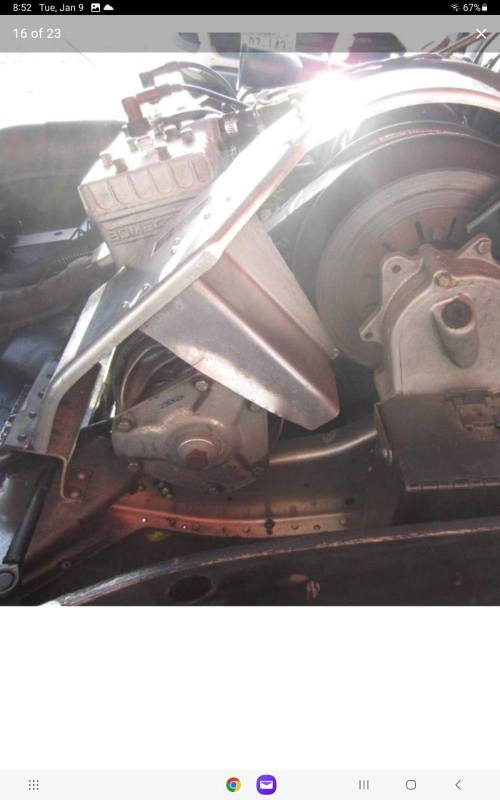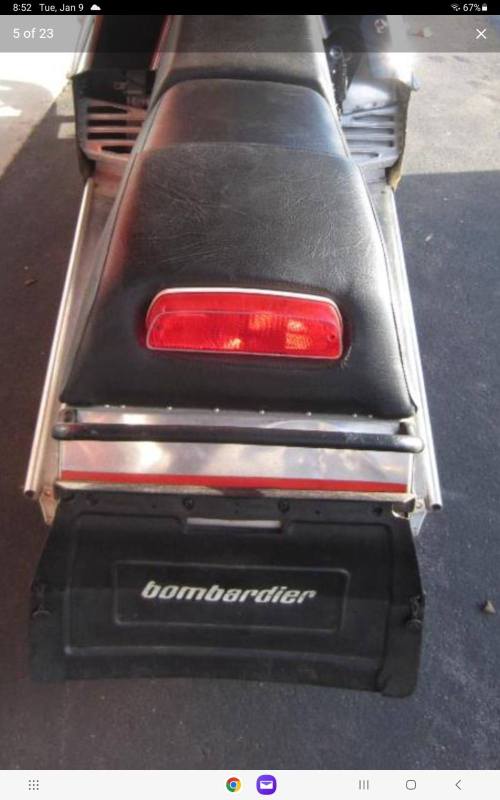-
Posts
5,198 -
Joined
-
Last visited
-
Days Won
11
Content Type
Profiles
Forums
Events
Everything posted by Doug
-
-
Topped off the groomer with fuel 280 gallons 😬. Heard a sled coming down the field just screaming like it was really hauling the mail. Looked and it was 2 kids on an old trail Indy. Good time 👍
-
Drag is hooked up now but getting windy and nasty out. Going to park it and go out tomorrow after the storm and wind dies down.
-
Was some stones but they make carbides everyday, price you pay especially this year. Carbides are fully junk now and going in the garbage.
-
Got some time grooming after we hooked the drag on. Trying to get the trails packed in with the strong winds tonight.
-
-
That's why I didn't want it to go to somebody else.
-
No can all stock. I hate cans causes trials to get closed
-
I bought this one from my friend last year. He didn't ride much and decided to sell it. Didn't plan on buying another sled but didn't want to see that one go to someone else.
-
6 hrs of driving to get 80 miles of break in time
-
This would be the QPQ treated shafts they use to use that would be pitted after 2-3 years. With them I'll take the chrome.
-
But pitted easily and take the seals out.
-
When Arctic Cat decided to copy Fox shocks but use a coated shaft that was a shock rebuilders dream. The number of shafts replaced with a chromed shaft after the coated shaft pitted was very profitable. 👍
-
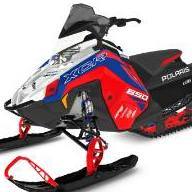
I’m so confused and ashamed , I need a shower or something
Doug replied to f7ben's topic in Current Events
Arron Rogers football talent yes. As a person wack job 🫨 -
Story of buried 1977 Kawasaki SnoPro sleds "Shark" from Vintage sleds. Long but interesting A rumor can be a dangerous thing. Here's how. We've all heard the rumors and stories about how some of the coolest sleds have been destroyed, locked in a warehouse, stolen or mysteriously disappeared, never to be seen again. One such rumor has persisted for many years in my neck of the woods: Those 1977 Kawasaki SnoPro sleds were buried, in tact, at some secret Kawasaki facility in Minnesota. I didn't think much of the story until late in 2000 when I was having a discussion with Jim Beilke, Snowmobile Hall of Famer, current executive editor of Snowtech magazine, and the one man show that originally wrote, photographed, edited and published that entire stack of Race & Rally magazines you've got locked up in your safe. One thing led to another and we started talking about those 1977 Kawasaki SnoPro sleds. Nasty, green, shark looking creatures driven by Jacques Villeneuve an Greg Channell for just one season. Jim reminded me of the story that when Kawasaki decided to get out of the snowmobile industry, they were afraid of liability issues from having those sleds around. He had heard that they went behind the shop one day, dug a deep trench, dropped them in and buried them. "Where was this workshop?" I asked. "Shakopee." He replied. My left eyebrow lifted just a bit as I quickly realized that Shakopee is a sleepy little town just south and east of Minneapolis - and not far from my house. A seed was planted in my head that would eventually grow into a giant, incurable disease. I had to know where that shop was 20 years ago and where it is today. I had to know if the rumor was true. Jim agreed to call around to some of his old contacts and see if he could verify the story or tell me where the shop was or is. While Jim was searching from one direction, I headed off into another that's easier for me: I searched the Internet high and low for any information about Kawasaki Motors Corporation in Minnesota. Tax records, court records anything. No luck. As far as the Internet is concerned, history began in the 1990's and nothing prior exists. I never did hear back from Jim, but he's always been a very busy guy, so I didn't press it. The thought I couldn't get out of my mind is that they are just sitting there waiting for me. It's the good old American Dream we've all had of finding lost treasure. You know the story: so-and-so found a very rare such-and-such behind so-and-so's barn, bought it for $20, put a little work into it, won first place at every vintage show, then sold the damn thing for tens of thousands of dollars. Get rich quick. Win the vintage sled lottery. I was somehow certain I alone had discovered a major secret; I just needed to find out where they were buried, get a shovel, then sit back and wait for the waives of glory I would surely be afforded. January 13, 2000 About this time, I had met Mike Decker who raced back in the day and was on the Ski-Doo factory race team for bit. He seemed a nice enough fellow and liked talking about the old sleds. During one conversation I had with him, I asked him point blank: "Do you know where exactly Kawasaki had it's shop in 1976?" I asked. Trying to be coy about why I wanted to know. "Mmm, that would have been Shakopee." He paused for just a bit. "I suppose you know the rumor then?" he said. Damn it, now I had to let him know what I was up to. No. I thought to myself. I can't risk it. Better to play dumb. "No, what rumor?" I asked. "I heard they buried those Kawasaki SnoPro sleds behind the shop. Ever hear about that?" "Uh, no, well, I heard something about that.... I stumbled. "I wouldn't doubt it." He said, then continued: "It was very common back then. Ski-Doo buried dozens of sleds that today would be worth a damned fortune! Shakopee. Now two people had confirmed that the Kawasaki Research and Development center was in Shakopee, but I had no idea where in Shakopee. I went home and dug out the one promo picture I had that I thought might be the Shakopee facility. I also printed out maps of Shakopee and was pleasantly surprised to learn it's a relatively small town and I could drive the whole length and width in just a few minutes. If the building still existed, I was going to find it. I asked anyone else I met who was involved back then with racing very carefully about the rumor, the Kawasaki Shakopee facility and the race team. None of these people worked at Kawasaki, but they did add more to the original rumors that started to make the actual story harder to guess at. One story said all the sleds were crushed and buried. Another said they used a backhoe and smashed them to bits, then buried them. Many insisted that all were crushed but one, and some thought the one sled was either hidden, stolen or being stored by Kawasaki Corporate headquarters in California for liability reasons. Another thought kept driving me nuts. I couldn't have been the only one to have heard this rumor! Others must know about it, and someone, in all this time, must have hunted this facility down. For all I knew they could have already dug them up and had them in their garage for many years now. Still I had to press on. I had to find out for myself. On my first trip to Shakopee, I looked in all the industrial sections of town. I was searching for a building that had bricks that were all perfectly lined up, as in the 1977 promo shot. This seemed to be a good approach, as most brick buildings in Minnesota have a staggered brick pattern. The other clue would have been the tree in the background of that promo shot. It's down in a hole, it has very definite cuts on some branches, and it's a very big tree. If time, fire, wind or man hadn't destroyed that tree, I knew it would be a good clue. After several hours of driving around, I never found a building with that brick pattern. I began to assume the building had been torn down, re-bricked or some how covered. It was a nice Sunday afternoon, so I stopped in to the only store that was open; the local hunting shop. After standing around for several minutes while the store owner helped the large number of hunters with the animals they had brought in, I finally managed to ask him about the facility. "I know this is a strange question, but do you have any idea where the old Kawasaki facility used to be?" The room went silent. All eyes turned towards me. I became very aware of the amount of fire power in the room, of which I had none. A gentlemen at the far end of the store positioned himself so he could see me and cocked his head to one side. "Why would you want to know that?" He said, scrunching his brow at me. How do I explain this without sounding like a complete wacko who wants to dig up 20 year old snowmobiles? "Just curious, I was a big fan of the old Kawasaki racing sleds" I said. Not a real lie, but not exactly the whole truth. After all did he need to know the whole truth? He straightened his head out and grinned a bit and said: "Hell everyone knows where that was. Damn sleds were louder then hell!" An uncomfortable giggle broke out amongst the hunters. "There ain't nothing there though - it's some other company now." We continued to talk for a bit and between this guy and the shop owner. They told me stories about the testing of the sleds that went on at a near by lake. They told me about all the noise complaints. These were some very nice people, all very happy to help a complete stranger. God I love Minnesota. A crude map was formed. I thanked them all profusely and tried not to act too excited as I raced out the door to my car. Damn this was exciting. I found it just by asking, didn't get shot, and didn't get involved in a scene from Deliverance. Shark Hunting Part II The Sharks In The Day December, 1976 - Alexandria Minnesota, the Dayco Holiday Spectacular. My morning had been fantastic. Since October I had been reading about and memorizing photos of the 1977 Polaris factory race sleds. The Polaris promo picture showed a new leaf-spring 440 twin SnoPro sled that frankly was the sexiest thing I had ever seen since Valerie Bertinelli on the tv show One Day at a Time. When I saw the new Polaris sled, combined with the knowledge that Polaris had an amazing new driver by the name of Brad Hulings, I knew Polaris was going to have a great season. On this particular morning, I actually got to see the sled up close and personal. That little Polaris was 10 times was cooler than I thought it would be. Valeri Bertinelli Only a couple SnoPro sleds could compete in the looks department with Valeri. Kawasaki's entry was one of them. Everyone I talked to that morning was making a big deal about the Polaris race sleds with the new weird suspension in the front. I could have cared less. That leaf-spring sled was much cooler looking to me. Only one thing was making me nervous for the Polaris squad that morning: My first look at the Kawasaki SnoPro sleds. The Kawasaki's looked every bit as good as my beloved leaf spring Polaris, perhaps better! I watched as the Kawasaki crew unloaded them. They were tiny. The gold tunnels shined in the early morning sun. The green hoods were polished to the point of being blinding. I got a sick feeling in my stomach that these machines were going to kick some serious ass. I would have the same sick feeling several years later when Valeri Bertinelli married Eddie Van Halen. I could never decide what was worse: A drug-addled rock star with my Valeri, or the nagging thought that Valeri would become a Yoko Ono and ruin my beloved Van Halen. As it turned out, Brad Hulings, Steve Thorsen, Jerry Bunke and Polaris ruled the day. They had dominated at the first race that season in Ironwood Michigan, but no one paid much attention; Ironwood had bad weather, and everyone had bugs to work out. By the time the big 15 lap 440X feature race was ready to roll, Hulings had already sewn up the coveted Hetteen cup, and it the boys from Polaris had earned a new nickname: The Midnight Blue Express, playing on the fact that their new sleds went around the corners like a train on rails. The 440X race started off scary for us Polaris fans. It wasn't a red white and blue machine in the lead, it was a green one! Jacque Villenueve was out handling and out motoring the Polaris sleds! It was very exciting for all the fans there, myself included: After the Polaris domination early in the day, Kawasaki was the under dog - much like Brad Hulings had been the underdog one year ago in this very same 440X race on his Mercury Snow-Twister. But just like Brad's historic run against the big factory boys in a big money feature race, Jacque went down to mechanical troubles. A small piece of debris got lodged in his fuel line, and the race was all over. But he likely wouldn't have won anyway; with each lap, Jerry Bunke had been gaining ground, and just a few laps into it, Jerry was passed Jacque, as was Brad Hulings before Jacque lost power. Jerry Bunke, (most people had never heard of Bunke at the time) would go on to win the race, with Hulings and Polaris team mate Jim Bernat rounding out the top three. It was a bitter disappointment for the Kawasaki team. A big early season win would have gone a long way in getting the corporate office more interested in racing. As the season went on, it was more of the same with the Kawasaki team; always a brides maid, never a bride. Polaris just plain out-gunned them and everyone else. Corporate Kawasaki was not happy with the expenses of racing; starting with the $1,500 a piece leather suits that team manager Gary Mathers bought for everyone, to the motor development, to the travel and race entry fees - it was too much. Corporate pulled the plug before the season was over, but did let the team finish out at the final race in West Yellowstone. Several people saw the Kawasaki Shark's loaded onto the truck in West Yellowstone in March of 1977. But where they went from there is more than a little speculative. It would be 23 years later before a SnoPro fan who watched them race in Alexandria earlier that year would be on the trail to find out what really happened to those sleds. Shark Hunting Part III The Kawasaki facility in Shakopee, MN. After getting my map from the guys at the hunting shop in downtown Shakopee, it took me only a few minutes to find the old R&D shop, just outside of Shakopee. It's across the street and down a bit from Shakopee's big amusment park, Valley Fair. I really was stunned to see the building, still standing, and looking damn good for being 26 years older then when I saw it first in the promo picture. This must kind of be how they felt when the cameras first found the Titanic! The bricks matched up as in the photo, all neat and in tidy rows. The building was the shade of puke green as I had guessed it would be. It looked like the paint was fresh. From this promo shot, I noticed the bricks and the tree. I found the facility almost 30 years later - The second shot shows the tree is about the same. It was now owned by a company called ChemRex. Damn! a chemical company will never let me dig in their backyard! They for sure have stuff buried back there they don't want the Environmental Protection Agency to know about. It was Sunday, no one was around, so I drove out back. There was the tree, looking almost exactly like it did 26 years ago! Amazing. It didn't seem like it had even grown any. I took some pictures and headed back for home, unsure of my next move. How do you approach a chemical company and ask for permission to dig in the back yard? Back at my desk Monday morning, I decided to just call and see what happens. I had nothing to lose. If worse came to worse and the Chemical company didn't want nothing to do with digging in the back yard, I'd formulate a plan to go out in the middle of the night and do it when no one was looking. At ChemRex, I asked to speak to anyone in charge of the building, or who had been with the company for a long time. On the phone, I got Larry Benjamin, an executive from ChemRex. I asked him if he knew anything about his building having once been the property of Kawasaki Motors. "Yeah, I know quite a bit about it. When we bought it we had to clean up their mess. What are you looking for?" "Well", I said, "I think they were testing snowmobiles there and..." "You aren't looking for buried treasure are you?" He interrupted."Those snowmobiles are long gone". The old test track - stomping grounds of the Sharks - in the back (behind the tree) is still visible. Well, that cleared up my thought about someone else having dug them up. I was a little late on this story. "What do you mean?" I asked, expecting to hear the worst. I figured my hunt was all over. "Those snowmobiles cost Kawasaki a whole lot of money. We heard that rumor before we even bought the building". Now I knew it was over. But on the chance that I was wrong, I asked if we could have a meeting and discuss it further. We set it up for early the next week. I met Mr. Benjamin at the ChemRex office the following Monday. He smiled and shook my hand, a confident looking man who didn't seem real happy about me taking this time out of his day. I told him I was grateful he could indulge me. We talked about he facility, which they bought from the Conklin Company in 1992. Kawasaki had built several lead lined chambers for testing engines, as well as a pool for testing Jet-Ski's. They also built a track in the back for testing snowmobiles. I drew a map with his help, and he showed me the spot were the snowmobiles were buried. Past tense. Were buried. "You said they were buried. What happened to them?" I asked, and that's when he told me the real story behind the rumor. "We heard the rumor before we bought the building. Being a chemical company, we felt it important to clear up any environmental issues before we moved in, so we decided to report the rumor to the county. The county was very interested and sent someone out right away". A better shot of the tree that hints at the secret of where the Sharks are. An official from Scott County came out with a metal detector and began searching. The metal detector found traces, big traces of metal just below the surface near the old race track behind the facility. They contacted Kawasaki, and ordered them to dig them back up. "And that's all I really know about it. Scott County got a hold of Kawasaki, and before I knew it, they were out with backhoes digging stuff up. They hauled it to the local dump. We got it signed off, clearing the way for us to buy the building and we felt we had done our duty towards the environment". Wow. The damn rumor was true! Maybe they were still at the dump? I thanked him profusely for his time, then quickly headed back to my office, barely able to concentrate on driving as I thought about what I had learned. Maybe they were still in the dump? Maybe there was still a chance I could find them? After sending out some emails, I got one back a day or so later from Scott County. Yes, they had a record of an environmental incident with Kawasaki, and yes, all I had to do was call a Mr. Peter Schmidt, and I could get all the info I needed. After all, it was all a matter of public record. I made an appointment to see him the next day. Looking forward to the 1977 racing season is the new Kawasaki SnoPro team. Back row: Jerry Witt, Gary Mathers, Richard Unce, Ray Tuggle. Front row: Jacque Villenueve, Greg Channell. Shark Hunting Part IIII The Possible Burial Ground of the Sharks Peter Schmidt of the the Scott County (Minnesota) Environmental Health Agency faxed me the total report he had on file about the incident. They tell the tale of what happened to these historically interesting sleds. The Burial Grounds? 1988 Paperwork from Scott County clearly shows that snowmobiles were found and dug up at the Facility. Where these the Sharks? The story goes like this: Lee Markgraf of Kawasaki industries was notified by Scott County that the current owners of Kawasaki's old Research and Development facility, The Conklin Company, had heard a rumor that they (Kawasaki) had buried snowmobiles there. Kawasaki executives and their lawyers decided that the best way to deal with it was to just admit it, dig them up and dispose of them properly. Scott County was to monitor the progress and removal, and make sure no hazardous materials was left behind. According to Peter, they first checked with metal detectors and marked the property. They then brought in the backhoes to begin digging. This is the text of a hand written notes from the Scott County official on the scene the day of the dig, whose name is not on the slip: "10-26-88. Pete visited the site with Lee Markgraf and Dave from Turner excavating. Complete and incomplete snowmobiles found in one small location - no oil or gas smell in tanks of vehicles, (verified by Pete, Dave & guy from Braun engineering before). Ten other holes dug around this hole - no evidence of previously disturbed soil - or of any solid waste." Markgraf then sent a letter back to Scott County with the receipt from Turner Excavation for $1,991.75, and a receipt from the Louisville Landfill. Kawasaki had done the right thing and cleaned up their mess. Mr. Schmidt completed a report and mailed a copy back to Kawasaki. Case closed. But note that the report says complete and incomplete snowmobiles. Could this mean that an in tact Shark was sitting in a landfill here in Minnesota? 1977 Kawasaki Race Sled I asked Mr. Schmidt if it was okay if I were to review the file in person. He agreed, and met with me at 8:00 the following morning. Peter was very good about telling me everything he could remember about the disposal of the sleds. "We were concerned about gas having been dumped there. We didn't know about the snowmobiles until they were dug up. I just sniffed them, literally, for gas fumes, but found none. They were hauled off to the Louisville landfill, we signed off on it, and that was that". So they Kawasaki SnoPro sleds were in the Louisville landfill? Images of the landfill owner having the sleds, or the sled parts in his garage, must have made me appear to Mr. Schmidt as a deaf, dumb & mute. "Is that landfill near here?" I grabbed my pen in anticipation of my next stop. "It's just a mile or two away, but now it's called Demcon." No need for directions, I'll just call Directory Assistance after I leave, I thought. I put the pen back in my pocket. "Do you remember seeing any hoods - particularly any green hoods?" I asked. "Mmm. Not really, I just took pictures of the holes and smelled for gas - there are pictures." He walked off in search of the file. Pictures! Bingo! Jackpot! KA-CHING! If I couldn't find the sleds, pictures would work nicely to prove once and for all that the sleds were here. The madness could end. Peter returned in just a moment with a packet of slides. He handed them to me, and I put them up to the light eagerly awaiting the first view of the Sharks since 1988. "I remember seeing yellow hoods. I don't recall anything green". Peter added. What's the chance that a green hood, after being buried for nearly 10 years turns yellowish after time? I thought. I couldn't see anything in the slides but some bits of parts mixed in with dirt. No clear shots of a sled at all. I asked if he would allow me to borrow the slides, long enough to have them printed as regular shots that I could see better. "They are public property, but it's not customary to let people check them out". He said. I did my best sad puppy face. "How fast can you have them back?" He added. "About two seconds after I get them back from the photo place". "All right then." I shook his hand with a smile and headed back to my office, some 20 minutes from Scott County. On the way back, I put in a message at the Demcon dump. I asked for someone named Dave that had worked their since it was called the Louisville Landfill. Yes, there was a Dave like that still working there, but he was not available, could I get your number and have him call you back. I gave her the number, we exchanged some Minnesota Nice chat, and I closed the cell phone shut. Damn. They might well be in the dump. There's still a chance I could find enough of them to restore one or more of them. But the pictures were puzzling. I couldn't see much, but what I could see in no way resembled the Sharks. I had to get them developed from the slides and blown up. Fast. I dropped them off on the way back to my office for 1 hour development. My quest was nearing an end, I could feel it. I will have solved the mystery. The blown up photos would reveal all. They were at the Demcon landfill. I'm not afraid of no rats! I would spend the next few weekends looking for them at the dump. I would find the elusive Sharks! I went back to my office and did my very best to pretend to be working for exactly one hour. I was pretty proud of myself thinking I may really have found them. Victory was mine! I would soon discover I had indeed achieved victory, but in the wrong battle. Shark Hunting Part V Four Feet of Clay "Mr. Preston, your pictures are ready". The voice on the other end of the line was from my new friend at the nearby photo developing shop. In the course of working on vintagesleds.com, I had become a regular customer, developing 2-3 rolls of film per week. I probably paid for her new car. "Thank you, I'll be right there". I put my cell phone down and went back to feigning interest in the meeting I was in. Something about a Mission Statement, and adding yet another product to our line of 25 unrelated products, blah, blah blah. The Burial Grounds? You can see what is left of a snowmobile in this photo... but what was it? Actually, I couldn't think. I had to see those photos now. I summoned up my best get-the-meeting-over-with-quick skills and within minutes was off down a Minneapolis skyway towards the photo place. It was near lunch time and it was cold outside, making the skyway very crowded. A crowded skyway is good. Crowded skyways tend to be crowded by very good looking women. Knock down, drag-out fabulous babes. Models. Bankers. Sales persons. They come in all shapes, sizes, colors and builds. A veritable smorgasbord. Yummy. But I digress. Finally, I was sure, I could see what was left of the Sharks. I got the photos, paid the fees, smiled at my photo finishing friend, and headed for the nearest well-lit area so I could take a look at the pictures. My heart racing, I tore open the cardboard the photos were neatly packaged in and I began flipping through them, staring intently at each of them for about several minutes. The more I flipped and stared, the more my fast beating heart began to grind to a slow, plodding thud. In disgust, I dropped the photos to the table. I had to conclude that the photos are inconclusive. The Burial Grounds? From this photo you can see how many places they were able to dig up sleds from. I muttered a curse to myself and headed for the nearest Caribou coffee shop. I got a hot cup of java, pulled up a chair and stared at the pictures more. The coffee helped ease my disappointment as it warmed me up. You can see a lot of parts, but no complete snowmobiles as the report had said. I see a chassis, upside down with an IFS system. But it doesn't look like the ones on the Sharks. I can can see what looks like parts of a hood, but it's yellow, not green. I can see a seat, it doesn't match the Shark seats. I see gas tanks. No match. I see all kinds of parts. None of them look like Shark parts. Damn it! I have to conclude their is nothing in these photos that positively identify this debris as the my SnoPro sharks. Nothing. Late in the afternoon one day later, I got a call from Dave at the Demcon dump. More bad news. He didn't remember any snowmobiles coming in the dump. Worse, the Louisville Landfill was condemned by the State of Minnesota sometime in the early 1990's because it contained both domestic and commercial garbage and was probably hazardous. They ordered it covered with 4 feet of clay. It's an area about 8 city blocks square, covered in 4 feet of clay. Even if you had the time and the resources to dig in search of the sleds, Dave informed me that the state would never, ever allow digging in that area, probably for a period of twenty years or more. How long does it take for aluminum and fiberglass to decompose? So that was it. End of the trail, end of the story. The Sharks are buried in a dump that can't be messed with. I can finish my story and put this rumor to rest, once and for all. But the pictures bothered me. They did not prove it was the Shark sleds were the sleds buried there. They just proved some snowmobiles were buried there. I was staring at the Scott County report later that day and decided to just check if Lee Marcraft still worked for Kawasaki. After doing some digging, I finally found Lee, working for Victory (Polaris) Motorcycles in Wisconsin. To my joy, he was willing to talk about the Kawasaki's as he no longer worked for them. "Oh that damned rumor!" He laughed out loud. "That damned rumor about snowmobiles being buried behind that plant has followed me around for decades, and caused me more damn grief!" he continued on. He told me the story much the same way Peter Schmidt of Scott County had told it. The building was being sold and Kawasaki decided to clean the mess up. The sleds were buried for liability reasons. They were crushed with a backhoe and buried just a few feet down. "Yeah, I suppose you don't want consumers driving any race sleds around huh?" I asked. "Race sleds? Oh hell no. These were prototype consumer sleds. Kawasaki was going to be the first to introduce consumer IFS sleds. We had them all ready to go into production when Corporate pulled the plug on the snowmobile program". A mild pause as I collected my thoughts. "Then what happened to the race sleds?" I asked. "Don't know. I never saw them. But I do know the guy at corporate that would know that. Let me give him a call, and I'll call you back. He'd know what happened to them." The trail was hot again! The Burial Grounds? One of the mechanics working hard, Alexandria Minnesota. I waited patiently for a week and tried Lee again. He had not heard from the person who might know more about the Sharks, but would keep trying. He did tell me that when Kawasaki had the facility in Shakopee, one of the SnoPro sleds was stolen. But the moron who stole it parked it in his front yard and was arrested and the sled recovered within a few hours of its disappearance. I never heard from Lee again, nor have I tried to contact him again. I later found out who he was trying to contact at Kawasaki. It was, I believe, his former boss. After several frustrating days of trying to find this guy within Kawasaki, I was told he had quit just a few days before. As the temperature dropped here in Minneapolis, the trail seemed to be getting colder. So I decided to start contacting anyone associated with the Kawasaki race program. First on my list: Ray Tuggle, the teams primary engine builder. One thing I've learned from a few years of digging up old race sleds: The drivers don't remember much. The mechanics, on the other hand, remember amazing details. Shark Hunting Part V Shark Details With Ray Tuggle Close up of the leaf spring version without the hood. Note the 4 plug motor. At this point in my treasure hunt, I had given up on trying to be sneaky. I decided to just be bold and hope that mighty forces would come to my aid. I decided to go directly to those that were involved with the Kawasaki race team. I tried Jacque Villanueve first. Not having a clue where to find him, I emailed the only email address on his website. It turned out that that email address was answered by his web designer, and I used the term designer loosely. He was a snotty little puke with an attitude. "Mr. Villanueve doesn't allow for direct contact" he wrote back. So I asked if he could forward a note on to Jacque. "As an act of charity, I suppose I could do that" I'd heard on more than one occasion from more than one person that Jacque is very nice guy. I was pretty sure this guy was on a power trip as Jacque's gatekeeper. I composed a nice, short email and asked him if he knew where the sleds might be, would he mind being interviewed about them for the web site, and what could he tell me about the sleds themselves? I've sent that email to his web guy twice over the next month, and I've received no reply, other than the web designer with "I'm very busy. I'll ask him about it when I can". Jacque, if you read this, please fire your web guy and hire someone more interesting. This shot from International Falls via Race & Rally magazine give a great amount of detail about the leafer version. In the meantime, I decided to get a hold of Ray Tuggle and see if he was more talkative. Ray was the Kawasaki racing engine builder and mechanic. To my joy, Ray was more than happy to recall anything he could about his experience there. Q: How many of the 1977 SnoPro sleds were built? A: "Each driver had 3 sleds, a 250cc, a 340cc and a 440. The 250cc and 340cc classes had to be factory stock but modifiable, according to the rules. The 440X machines allowed for anything. You know, if you would have asked me these questions ten years ago, I would have probably had to keep my mouth shut, but it's been so long ago now, I guess it's okay to talk about it. The 250 and 340 engines weren't exactly, uh, stock, if you know what I mean! (laughter) I think there was a total of 11 or 12 of them, several as backups or spares." Note: Since this interview, I've found no evidence of 250cc Kawasaki's. In digging through the old SnoTrack race records, Kawasaki only shows up in the 340cc and 440cc class. Q: Did they all start out as leaf-springs front ends or some IFS and some leafers? A: "Greg (Channell) wanted a solid front end. Jacque wanted the IFS. But after Polaris started to clean our clocks, it was apparent to Greg that the IFS was the way to go. By the end of the season, all the sleds had IFS." Q: None of the leaf-spring models survived? A: (Pause) "I don't think so. Maybe some of the back-up sleds remained leaf-spring, but it's been twenty some years, I guess I don't remember. Some may have never been converted, but no one was driving anything but IFS by the end of the year. We did work on three sleds having prototype fiberglass springs, but we abandon that as they didn't really work all that well." Q: What can you tell me about the engine and the clutching in the sleds? A: "Mr. Fujikawa of Kawasaki Japan specifically required us to run the twin-plug Kawasaki engines in everything except the 440X, where we had the room to experiment more. These were extremely ported engines, with Kawasaki clutches. The 340 and 440's were mostly production cylinders, but the 440X cylinders were all prototypes." This very rare shot from CJ Ramstad's archive shows the most detail of the IFS version in any photo I have ever seen. Q: What else was unique about the machines? A: "We tried a plastic cover for the chain case, but when we ran the first endurance race, the chain case got hot, the cover melted and eventually the chain froze up. It was a good idea, it cut the weight down and allowed us to see at a glance how the oil was in the chain case. It just couldn't take the heat! Other then that, I didn't work much on the rest of the sleds." Q: I have an old Sno-Week article that says the chassis were actual production chassis - maybe even from a Thunderjet? Is this true? A: "No. They were custom built by a guy in McGregor, Minnesota.We gave him the specs and he machined them into place." Note: I think the question was mis-understood. I think the bulkheads were made in McGregor, but from pictures you can clearly see that most, if not all the tunnels are gold 75 Thunderjet tunnels. Q: Did they have serial numbers on them? Would anyone know what they are? A: "I don't recall, but in order to get through the inspection process, you would have had to match the engine parts to a chassis, and the only way to do that was with a serial number. They must have had them." Ray Tuggle. One of the mechanics lucky enough to work on a real Kawasaki Shark! Q: What was most memorable part of the year (1977) for you? A: "Earlier in the year, Jacque came really close to winning the 440X championship in Alexandria. He was so close, just a few laps, and it would have made such a difference in the program. But he just coasted to a stop on the back stretch. Dead. We thought he blew the motor, but it turned out to be a small piece of rubber that had clogged the fuel line and stopped the motor. We almost shed tears over that loss, it was so close." Q: Do you know what happened to the sleds after the year was up? A: "I helped get them on the truck, and they went back to the facility in Grand Rapids, Michigan. I would assume they were destroyed there. But I don't know for sure. That was the last I'd seen of them. It would be sure neat to see them again." Yes, it sure would. I thanked Ray and hung up the phone. Maybe the original story of the sleds being buried was true. Maybe I was just digging in the wrong state! Shark Hunting Part VI Shark Hunting in Grand Rapids Michigan So what was the fate of these remarkable machines? Gary Mathers Gary Mathers: He started his career in a big way as part of the Polaris racing team, then headed up the Kawasaki effort before moving on to motorcycles. This photo from the AMA Motorcycle Hall of Fame. "I went to California right after the last race of the season, and I can tell you that no sleds went there. None. No production sleds, no prototypes, no SnoPros" Gary Mathers told me just a few days ago. After searching for Gary all over Kawasaki and Honda for months, I finally got tipped off that Gary worked for the American Motorcycle Association. He called me back and sounded genuinely happy to talk about these incredible machines and his experience at Kawasaki. "We knew the design was good. We had the horsepower. But the chassis was a bit too long and the front a bit too wide. We needed more time and more help to really develop the sled. By 1978, I'm sure we could have had a winner." But as we all know, racing was ended for Kawasaki before the 1978 season could get started. As far as Gary knew, Duane Aho, the Godfather of the ThunderJet, was likely the guy at Kawasaki that wanted to go racing and got the racing program started. Aho may even have been experimenting with a ThunderJet tunnel on the new Kawasaki when Gary was brought in to replace Aho. They likely built one or two like that, but they were never used. The search was on for drivers soon after Gary came on board. "We had a heck of a time finding drivers. Everybody that was good was already signed up with another team. Greg came from within Kawasaki and was an easy enough choice. We got lucky when we got Jacque. Jacque was a very hard worker and really tried hard". I asked him about those great looking leather suits the team had. "Truth was, Kawasaki's clothing line was just awful. So I called up Bates and ordered new suits for everyone. I caught all kinds of hell for that. But what else could I do? Everyone kept their leathers at the end of the year. I had mine until I sold them to some fellow who could fit into them. No idea where they went from there". Of course this means that Channell, whom I've not spoken with, Jacque, & Witt may still have theirs. Ray Tuggle confirmed his leathers are still with him. "Did any of the drivers get to keep a sled?" I asked Gary, hoping to spark a memory. "No" came the answer I didn't really want to hear. "We had no policy for that. Each driver had a practice sled that they could take home to practice on, but they were consumer models, not the SnoPros. They may have those". Gary's legacy with Polaris in 1974 was an extremely successful race team. He continued on to tell me that he dearly missed the boys in Roseau after moving on to Kawasaki. "They just did what needed to be done. They weren't all hung up on over-engineering everything. If we needed a part, somebody had made it before I had a chance to think about it. Eastman is just very good. He's still kind of my hero". We talked for some time about his experience at Polaris. I asked finally built up enough courage to ask what he knew about there whereabouts of the Sharks. "No idea. They probably got destroyed." We continued to talk for awhile about the practice all the manufacturers had of destroying some products by crushing them and burying them. I can only guess that this means they were likely crushed and buried near the Michigan plant, but for environmental concerns, no one at Kawasaki will ever admit that. I would speculate that only a precious few people ever knew they were buried, or where. There are two executives (one current, one former) at Kawasaki who I believe know the truth about the fate of the Sharks. I finally got information on the whereabouts of the former Kawasaki executive, but to date, he won't return a phone call. The other Kawasaki executive won't return a call either, and I've been trying to call him for almost a year. Kawasaki Truck The innards of a real factory race truck. To date, I still have not heard from either driver. They may know something about what happened to the sleds. I did get an email that Jacque had once given away some parts for the Sharks, some skis, a plastic chain case cover, maybe more. I'm still trying to get those parts or pictures of them. I have left numerous messages for Jacque, and no reply. Same with Channell. There was one other lead I've been following to no avail. It seems Kawasaki does have a storage facility where they store products for historical purposes. The facility manager there was "kind of sure" there is no snowmobiles at that facility, but he made it clear he would make no effort to look for them, either. Even if Kawasaki did save some sleds, it seems doubtful they would have held on to any of the Sharks, especially when you consider the fact that their racing record was not that good after 1977. But you really can't blame the Kawasaki team for having a bad year. Thanks to the crushing success of the Polaris "Midnight Blue Express" in 1977, no team other then Polaris could claim 1977 as a good year. It seems like the Sharks were loaded on to the truck after the last race in 1977 and drove off into the fog. From that point forward, the sleds were just plain gone. Like the Bermuda Triangle had swallowed them. Except for the photos and maybe a few parts, there's no proof they ever existed. All the effort and time that was put it to them, including my effort to try and find them over 20 years later seems like such a waste. I will forever hold out hope that maybe, just maybe, someone will be able to come forth and give you and I some kind of closure. I would prefer an ending to the story where at least one lone surviving Shark is found, under several feet of dust in a locked up warehouse. Or maybe in the garage of someone that was smart enough to steal one and keep it under wraps all these years. Maybe it will wind up in the Snowmobile Hall of Fame where hundred of people every year will be able to see how cool of a sled it was. There is always the possability! This whole Shark hunt started for me on a rumor that the Sharks were buried behind a building. It ends on a rumor that they are buried behind a building, just not the one where I was digging. I sincerely hope that someone who knows the truth will read this article and give me a call. Or an email. Just because my Shark Hunting ends here, doesn't mean the story has to.
-
-
-
Looking closer think the 78 RV Blizzard may be my old sled from the 80's. I got hit in the back and bent the tunnel enclosure a little and put a comet clutch on. The sled in the pics you can see where they straightened the tunnel enclosure right where I got hit and it has a comet clutch.
-

"EVs aren’t ready for prime time, they never will be"
Doug replied to XCR1250's topic in Current Events
-

"EVs aren’t ready for prime time, they never will be"
Doug replied to XCR1250's topic in Current Events
-
Seeing these prices is crazy I won't be bidding on anything. The 245 RV is another sled at $16750. Have a 1994 XCR 600 with around 300 original miles and a 1990-1/2 RXL with around 900 miles. Tempting to throw those out for sale after seeing these prices.




